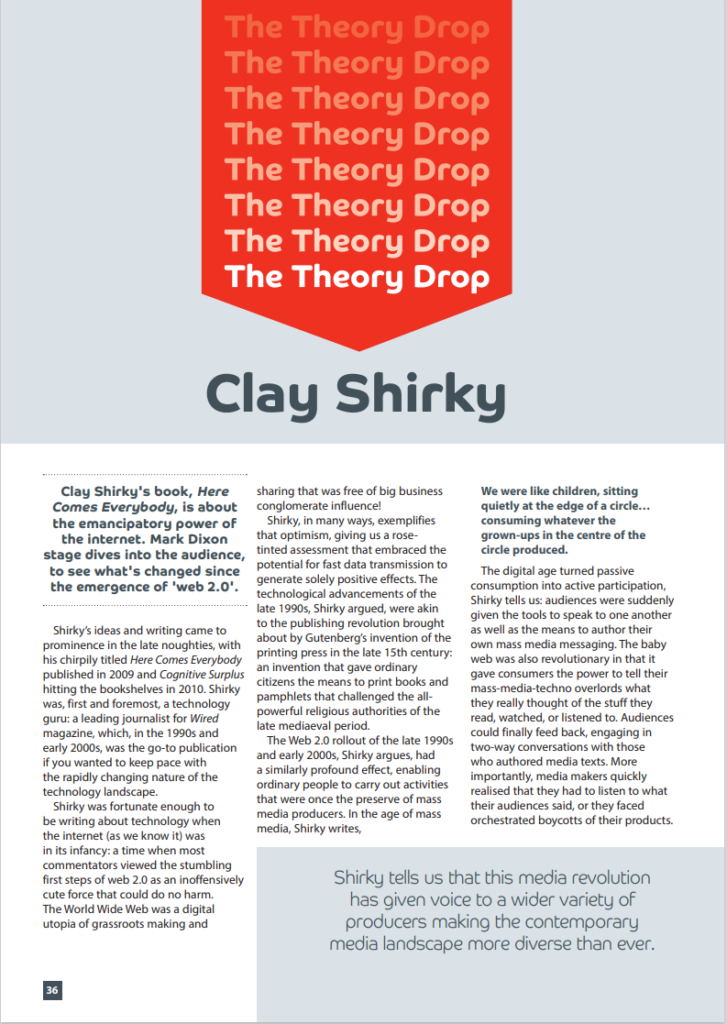





Steve Neale

How we moved from traditional solid structures to the shifting, uncertain markers of the new world?
If so how do we understand it? Ideas around the concept of POSTMODERNISM may help us to navigate . . .
Over the next couple of weeks as we run up to Xmas we will look at this topic. We will look at a couple of films and we will answer a couple of exam questions and then . . . it’s over!
Postmodernism can be understood as a philosophy that suggests society lacks an overall metanarrative – an agreed ‘truth’ or shared ‘reality’. This is because new media technologies have allowed us to build-up and exist in our separate and individual worlds. This means that our existence and identity is ‘fragmentary’ and ‘individualistic’. While this may gives us a high degree of freedom and control it can also have the effect of making us ‘alienated’, ‘isolated’, ‘lost’ and ‘anxious’.
If we are lost and alienated it means we have less power over society, ourselves and our existence.
The rise of new media technologies seems to illustrate that we are not quite in control of our own identity (or destiny – think work, health, education, society etc). This gives rise to what Jean Baudrillard calls a simulated, hyperreal existence. A world where the virtual (digital) may be more real than the real. It is a world where are not sure what is true or what is real – which includes both individuals (ourselves) and society.
Key characteristics of the postmodern world of new media technologies are: COPY, PASTICHE, PARODY, RE-IMAGINING, BRICOLAGE. It’s an approach towards understanding, knowledge, life, being, art, technology, culture, sociology, philosophy, politics and history that is REFERENTIAL – in that it often refers to and often copies other things in order to understand itself. Think of sharing, posting, sending, adjusting, editing – new media technologies allow you to copy, parody, re-imagine etc.
It is a world that prioritises style and surface over any substantial change or meaning – a world that is endlessly busy looking at itself . . . the selfie?
As such new expressions from new media technologies (particularly around identity and being) can be seen as a massively complicated and fragmentary set of inter-relationships – think how many pictures, videos, texts are produced, stored and recorded every second of every day! This is a practice of re-imagining, pastiche, bricolage and self-referentiality, which may be understood alongside another key expression / concept: intersectionality – which provides evidence for how we see ourselves and the world and how we exist as human beings in contemporary society.
Postmodernism can therefore be understood as a way of understanding and categorising the new world – dominated by new media technologies. It could be said that it is a world that is more interested in the self, in play, in the visual, the surface, the personal. And can often been seen as frivolous, trite, casual, surface, throw-away. If anything it is dominated by an economic model based on consumption (ie buying stuff). So while it may even be seen as ironic, joking, or literally, ‘just playing’ it is usually underpinned by a transactional economic exchange (ie buying more stuff!).
However, it is most often a deliberate copy (of the old). Therefore, the old has been re-worked into something new, which clearly entails a recognition (a nod and a wink) to what it was and where it came from.
It also suggests that we live in a meaningless, irrelevant and pointless stream of replication and repetition.
. . . a complex network of texts invoked in the reading process.
See this source for link to Kristeva and post-structuralism
So can we start to break some of these ideas down a little bit . . .

pastiche is a work of art, drama, literature, music, or architecture that imitates the work of a previous artist
parody is a work or performance that imitates another work or performance with ridicule or irony
BRICOLAGE is a useful term to apply to postmodernist texts as it
‘involves the rearrangment and juxtaposition of previously unconnected signs to produce new codes of meaning’
(Barker & Jane, 2016:237)
Similarly, INTERTEXTUALITY is another useful term to use, as it suggests signs only have meaning in reference to other signs and that meaning is therefore a complex process of decoding/encoding with individuals both taking and creating meaning in the process of reading texts. In other words . . .

As we approach the last few topics of this A level course and before we look specifically at the 4 New Media CSP’s:
we should briefly consider what we can understand about New Media in relation to Old (legacy) Media that we looked at in the previous half terms (ie TV, PSB, BBC, radio, Newspapers etc)
ARTIFICIAL INTELLIGENCE (A.I.)
So let’s start by listening to a conversation between a human and a robot.
To start off with I would like to prioritise the notion of CHANGE & TRANSFORMATION as a way of thinking about NEW MEDIA which can be linked to the key ideas of a media syllabus. For example,
In summary, this could be described as the changing nature of symbolic interaction and a lot of the work on this blog is essentially discussing this concept.
Dan Gillmor is a useful theorist to look at, you can read his book We Media by clicking on this link – provides an overview of how new media technologies have had an impact on relationship between citizens and government / institutional power.
For another example, look at the research paper by ResPublica: ‘Technopoly‘, which looks at the relationship between corporations, governments, individuals and BIG DATA. As the debate continues more information, debate and discussion will start to appear as we all become much more aware of what NEW MEDIA involves.
As such, looking at New Media allows for a re-thinking of the relationship between the private and the public (or as Habermas would put it ‘The Transformation of the Public Sphere‘ – as new technology is allowing the public world of organisations, commerce, government and business to infiltrate the private worlds of personal ideas, friendship and informal exchange, read this article from Open Mind: The New Media’s role in Politics.
Similarly, disclosure and analysis around Cambridge Analytica, the Trump election and the Brexit Campaign have brought these debates sharply into focus and any of these areas could be used as useful case studies to explore the impact of New Media on society and the individual.

PAPER 2 (LONG ANSWER) Online, social and participatory – news website, produced by and targeting a minority group.
The Voice as an institution has historical and cultural significance in its origins (1982) as the UK’s first (and only) newspaper aimed specifically at a Black British audience, dealing with relevant political and social issues. The website continues this function but is perhaps considered more mainstream and less political than in the past. The economic context can be explored through a consideration of the nature of the production and distribution and move to online content to reach a wider audience and attract advertisers.
The Voice is a commercial media product but could also be seen as fulfilling a public service through its targeting of an ethnic minority audience. The website also demonstrates the way that news institutions have had to respond to new technology through The Voice’s bi-media presence
and use of convergence.
These include the representation of the target audience – Black Britons – but also the selection and construction of news stories and their subjects. The analysis of representation can be used to explore target audiences and ideological readings.
The Voice CSP provides an example of a clearly targeted, primary audience through demographics of ethnicity, race and age, which should encourage the study of issues of identity.
Related to this would be a discussion of the changing relationship between producers and audiences – is there a need for media aimed at specialised audiences in the context of audience as producer? (Clay Shirky ‘end of audience’ theories)